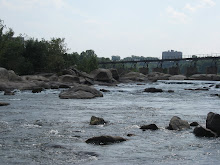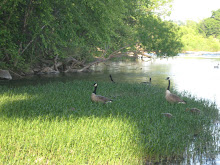For years I have was detered from taking up fly fishing due to the technicality of it, or at least that perception created by some who speak about fly fishing. Truth be known-fly fishing can be a gear techie's play ground, or it can be a simply graceful art. My goal with this type of post is to demonstrate to others that this sport can be simplified while you are getting started. As you become more familiar with the sport you can learn more complicated approaches (it is something to strive for). I can see the ellitist and purest cringing now. The complication should be associated with blending elements from the trying bench to stream rather than technicallities.
That being said, let me start out with knots. Now, granted, there has been a descent amount of research done pertaining the strength's of various knots and I imagine watermen will argue that you must be precise in choosing the right knot. Well of course they should-their life depends upon it. With this research and ages of knowledge derived from experience, an understanding of when to apply which knot has probably been created and is probably most sound. If you are new to the sport and do not have time to sit down and learn all these complicated knots (lets face it, we need to spend our limited amount of free time fishing rather than worrying about these items) I suggest learning one simple knot - THE OVERHAND KNOT.
The overhand knot can be used to attach your tippet to leader and leader to fly line using what I refer to as a jam knot (i.e. two overhand knots jammed against one other with the excess clipped). The technical term for this knot is a double uni knot, and it works best when we attaching two lines of similar diameter. I have found that it is a weak knot if the attached lines have drastically different diameters; however, the stiff but end of a leader approximates the diameter of many fly lines and the tippet's diameter is pretty darn close to that of the leader's end. It can also be used to form a surgeon's loop if you desire loop-to-loop connections (I find loop connections to be much easier relative to tying knots, and they slide through the guides well).
Check out these web pages for instructions:
http://www.realknots.com/knots/stoppers.htm
http://www.netknots.com/html/double_uni_knot.html
Again, the goal here is to start off simple so you can enjoy the sport rather than being discouraged by complexity. I am finding that the more I get out and fly fish, the more desire I have to learn the precise methods. If you try to start with the hard stuff chances are your fly rod may become nothing more than a dust collector.
July 31, 2008
Summer Report 2 - New Species Added to the List

 Picture borrowed from http://www.dkimages.com/discover/Home/Animals/Fish/Bony-Fish/Orders/Gars/Gars/Longnose-Gar/Longnose-Gar-2.html
Picture borrowed from http://www.dkimages.com/discover/Home/Animals/Fish/Bony-Fish/Orders/Gars/Gars/Longnose-Gar/Longnose-Gar-2.htmlIt all finally came together this morning-I hooked, played and landed my first long nose gar. It was a beefy fish, and was probably 30-35 inches in length. I caught it on a bar'ed olive zonker pattern (actually a zonker-woolly bugger hybrid). I have been trying to catch one of these prehistoric apex predators for over 6 years ever since I was first introduced to the species at Montezuma National Wildlife Refuge located in upstate NY.
It was hard dragging myself out of bed, and that god-forsaken snooze button actually kept me from making it to the river to fish first light. I made it out by 7am, and entered the river via the pipeline. I had spooked a gar in this stretch before wading out to a pool, so I knew they were around. I first casted along the grass line with no luck, and made my way to the other side of the stretch, perched myself on an expose boulder and looked around the water. Roughly teen feet away, a beautiful gar was sitting idly in two feet of water behind a pile of rocks. I casted to the fish, with the rod behind me as not to spook it; strip....strip....strip...STRIKE...strip. F@*%, I missed the fish! It followed my fly (a white version of the zonker mentioned above) too closely, saw me and dashed for deeper water.
I decided to head upstream to some deeper, faster water to try my luck with the smallies. The deepest pool, which looked amazingly fishy, did not produce a fish, nor did I even have any follows. I worked my way to the next rapid-pool area, fishing shallow white water in which I missed a hit from a red breasted sunfish. I proceeded to climb across an island, and waded out into flatter water to work on my casting. To my surprise, the area just downstream of the last drop was full of aggressive smallies yet I was unable to hook any (lots of follows and short strikes).
My back casting room was suddenly decreased as the Hispanic noodlers made there way around me. I chatted with them for a bit, and admired the 40+ pound Flathead they had wrangled up. I made my way back stream, and crossed in calmer waters as I was calling it a day. I have seen good looking largemouth in this area (flat run just upstream of the first islands), so I decided to wade with caution while fishing ahead of me. I made a lousy cast, began retrieving the fly and out of now where-materializing from the green, grey bottom-a gar appeared. It took one swat at my fly with its beak, then a second, then a third and by now had tangled itself in my line and the rabbit fur. FISH ON, GET YOU SOME!
I was standing in stomach high water, and the fish thrashed around and made several leaps clearing the water right in front of me; I was fearful that its thrashing would cut my line, but my 20lbs leader did the trick. After about five minutes of this display, I reached the shore with the gar, untangled it and watched it swim away after it gulping one more breath of air from the surface. INCREDIBLE, I thought as I looked to the sky and thanked the forces of nature for such an opportunity that serves as a reminder as to why I love this so much. And of course, my camera's batteries were kaput, so you will have to settle with a borrowed image (the noodlers took a cool picture of the fish though).
Check this site out for information pertaining to the gar:
Conditions: Bright and sunny, but the sky began to grow cloudy around 1pm. Water clarity is excellent (I wonder if this is part of the problem in terms of finding active smallies), and the tide was out; I was fishing a slack tide. It appears as though the tidal range in about 1-2ft this time of year. During high tide, the smallies were much more prevalent and aggressive. Smallies hit, albeit short, the olive bar'ed zonker with a white hackle belly; this same fish took the gar. They seemed to strike at the fly as it made its final swing. Temps ranged 75-90, yet quikly cooled to the upper 80s as the breeze picked up.
Casting Notes: I switched my grip to thumb up rather than forefinger (as if I were holding a golf club). I noticed as I get tired and lazy I begin to use my wrist to accelerate the rod....I really must focus on 'accelerated to stop' during the forward and back stroke. If I tilt my wrist inward slightly that seems to reduce the flexing of my wrist. This new Cabellas Tradition 2 rod is extremely fast, so a small slice only flexing the tip produces night tight loops. Made my first cast around 4oft!
July 30, 2008
Winter Fun- Near Shore Lakers







So envision this: it is 7am, gloomy, just above freezing, and Christmas morning. Where would you be? Chances are if you have young'ns you may already be cleaning up the wrapping paper, if not, your enjoying your cozy bed. But, if your obsessed like I am, your standing in chest deep water that is covered in a thin film of ice.
In the winter (November and December) lake trout concentrate in shallow areas at the mouths of tributaries where they can gorge themselves on warm water species. I have seen pictures from a local guide in which the gut contents of a laker was dominated by species such as largemouth bass and an assortment of sunfishes. From the trout's perspective-a cold water species-this time of year represents an awesome feeding opportunity; however, if you are a shore bound angler such as myself, this represents a shot at world class fish.
Slowly, I would cast pumpkin and white tube jigs and flukes into the stream's flow where in enters the lake working the tube across the bottom while swinging the jig. I wait for the violent tap of lake trout, set the hook, and then hear the line scream off my real. These fish fight very well despite the low water temps; they make a run straight to the bottom, and then head away from the shore. Eventually they tire, and you can land these fish. Lake trout do not receive the attention they deserve-their coloration is incredibly adapted to the lake bottoms they inhabit. Look at those golden swirls...man! I cannot wait to throw some flies at these fish this coming winter and I am already trying to develop a bluegill or smelt streamer.
We have also been rewarded by bonus browns and even a rainbow. We hooked into one rainbow that whacked an orange twist tail grub, which we battled for 15minutes. "Oh she's done fighting", my buddy Wormo Says, "I got it". As he begins to put tension on the line to grab the fish, the big female makes another run and SNAP.....
Schoolie Saves the Day!

April 2008 
On a gloomy friday afternoon I decided to walk through the city of Richmond seeking new water's to fish. I headed towards the popular 14th Street area knowing that stripers and shad had finally made there way up the James River. Turns out days prior to this trip the river's flow had gone way up and shad fishing turned off.
On the way I found access to a new spot of the river: lots of boulders, nice runs, big rapids, sandy points and carp splashing around. Looked awesome, and I was kicking myself for not finding this area a year sooner. I saw several anglers casting what appeared to be broom handles cut in half and painted red and white. They were not really casting, but rather launching these top water lures entirely across the river. After chatting with these fellas I learned that the stripers/rock fish held in the area before moving upstream feeding on herring. Needless to say, I was convinced this would be the area to which I returned to the next day.
4:30am greeted me with the ever-so delightful sound we are all familar with (grrr) and rather cool temps (60 or so). I made my way to this new location, but fished z popular pool for a couple hours while I waited for the sun to fully rise. I eventually made my way the new stretch of river, waded in past some anglers and started drifting a swift run composed of boulders and gravel. After fishing this spot for two hours, I moved upstream to the next sandy point. I opted for a size 6 seducer tied with polar fibers and white hackle and weighted red eyes.

On a gloomy friday afternoon I decided to walk through the city of Richmond seeking new water's to fish. I headed towards the popular 14th Street area knowing that stripers and shad had finally made there way up the James River. Turns out days prior to this trip the river's flow had gone way up and shad fishing turned off.
On the way I found access to a new spot of the river: lots of boulders, nice runs, big rapids, sandy points and carp splashing around. Looked awesome, and I was kicking myself for not finding this area a year sooner. I saw several anglers casting what appeared to be broom handles cut in half and painted red and white. They were not really casting, but rather launching these top water lures entirely across the river. After chatting with these fellas I learned that the stripers/rock fish held in the area before moving upstream feeding on herring. Needless to say, I was convinced this would be the area to which I returned to the next day.
4:30am greeted me with the ever-so delightful sound we are all familar with (grrr) and rather cool temps (60 or so). I made my way to this new location, but fished z popular pool for a couple hours while I waited for the sun to fully rise. I eventually made my way the new stretch of river, waded in past some anglers and started drifting a swift run composed of boulders and gravel. After fishing this spot for two hours, I moved upstream to the next sandy point. I opted for a size 6 seducer tied with polar fibers and white hackle and weighted red eyes.
As the fly swung downstream, I felt this quick tug and my line took off. After hand-lining the fish I saw this blueish glow coming out of the water, and, sure enough, I landed my first striped bass. Now, this fish was only about 8-10inches in length, and after hearing reports of 40+ inch fish I realized this was just a dink. But, you must keep several notions in mind: there are no striped bass in the Finger Lakes, this was one of my first fish on the fly, and in 8hrs of fishing I saw no other fish caught.
As sad as it is, an 8 inch fish made my weekend and has me itching for next spring with a shot at one of the big cows!
First Blog - Summer Report 1

JULY 28, 2008
Ah so here it is. This Monday was my 25th Birthday, and I spent it with my favorite person-OLD MAN RIVER! He may be a cranky, tempermental fella, but he only has objective things to say to me which manifest themselves through the roar of a rapid or the trickle of riffle.
I love smallies as they are incredibly aggressive, spunky yet, at times, difficult to trick. This day though I struck out and only managed a whopping skunk fish in terms of smallies; however, I nailed two new species for me. (1) A white bass and (2) and a channel cat. The white bass took a barred olive zonker and the kitty nabbed a similar white zonker. I was amazed at how quick that cat turned around as my streamer nailed the water's surface...all it took was three short strips and a strike ensued. My seven wt. did a nice job handling this 2-3 pound fish, but for the first time I felt line being ripped of my reel....MAN THAT WAS NICE!
I learned two major items on this trip. First, smallies LOVE hanging out on the upstream side of rocks and boulders, especially among rocks located just below fast deep water before the next set of rapids. I suppose the rock slows flow by causing water molecules to stop and pile up, just like a dam but on a smaller scale. I wonder if the smallies just hang in that slack water waiting for food morcels to wash out of the main rapid?
Secondly, rabit fur (zonker strips) is an alive fabric: it undulates, pulsates, breathes, wiggles etc. I will definately be tying some more streamers with this stuff. Up till now I have been relying on hackle, marabou and bucktail. Needless to say, not any more.
The camera was without batteries, so this blog is without pictures. I have located some awesome largemouth, and my next trip will be devoted towards paying them a visit.
Conditions: Mostly sunny, temps started out near 70 and reached 90 by 2pm. Night before experience heavy thunderstorm down pour; flow looked up a tad, but river is at summer low flow. Very clear.
Ah so here it is. This Monday was my 25th Birthday, and I spent it with my favorite person-OLD MAN RIVER! He may be a cranky, tempermental fella, but he only has objective things to say to me which manifest themselves through the roar of a rapid or the trickle of riffle.
I love smallies as they are incredibly aggressive, spunky yet, at times, difficult to trick. This day though I struck out and only managed a whopping skunk fish in terms of smallies; however, I nailed two new species for me. (1) A white bass and (2) and a channel cat. The white bass took a barred olive zonker and the kitty nabbed a similar white zonker. I was amazed at how quick that cat turned around as my streamer nailed the water's surface...all it took was three short strips and a strike ensued. My seven wt. did a nice job handling this 2-3 pound fish, but for the first time I felt line being ripped of my reel....MAN THAT WAS NICE!
I learned two major items on this trip. First, smallies LOVE hanging out on the upstream side of rocks and boulders, especially among rocks located just below fast deep water before the next set of rapids. I suppose the rock slows flow by causing water molecules to stop and pile up, just like a dam but on a smaller scale. I wonder if the smallies just hang in that slack water waiting for food morcels to wash out of the main rapid?
Secondly, rabit fur (zonker strips) is an alive fabric: it undulates, pulsates, breathes, wiggles etc. I will definately be tying some more streamers with this stuff. Up till now I have been relying on hackle, marabou and bucktail. Needless to say, not any more.
The camera was without batteries, so this blog is without pictures. I have located some awesome largemouth, and my next trip will be devoted towards paying them a visit.
Conditions: Mostly sunny, temps started out near 70 and reached 90 by 2pm. Night before experience heavy thunderstorm down pour; flow looked up a tad, but river is at summer low flow. Very clear.
Subscribe to:
Posts (Atom)

















